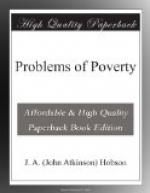The figures of London pauperism yield still more strange results. Here, though the percentage of paupers to population has shown a steady decline, the process has been so much slower than in the country that there has been no actual fall in the number of paupers. Throughout the whole period from 1861 to 1896 the numbers have remained about stationary, after which they show a considerable rise. The alarming feature in this table is the rapid rise of indoor pauperism, far more rapid than the growth of London’s population. From 1861-2 the number of indoor paupers has grown by steady increase from 26,667 to 61,432 in 1902-3, or from a ratio of 9.5 to one of 13.4 per 1000. While the proportion of outdoor paupers per 1000 is little more than half that of the country as a whole, the proportion of indoor paupers is more than twice as great. Roughly speaking, London, with less than one-sixth of the population of the country, contains nearly one-third of the indoor pauperism. This fact alone throws some light upon the nature of city life. A close analysis of metropolitan workhouses discloses the fact that the aged, infirm, and children composed the vast majority of inmates. A very small percentage was found to be capable of actual work. About one-third of the paupers are children, about one-tenth lunatics, about one-half are aged, infirm, or sick. This leaves one-fifteenth as the proportion of able-bodied male and female adults. As a commentary on the administration of the Poor Law, these figures are eminently satisfactory, for they prove that people who can support themselves do not in fact obtain from public relief. But the picture has its dark side. It shows that a very large proportion of our workers, when their labour-power has been drained out of them, instead of obtaining a well-earned honourable rest, are obliged to seek refuge in that asylum which they and their class hate and despise. Whereas only 5 per cent of the population under 60 years are paupers, the proportion is 40 per cent in the case of those over 70. Taking the working-class only out of a population of 952,000 above the age of 65, no fewer than 402,000, or over 42 per cent, obtained relief in 1892. In London 221/2 per cent of the aged poor are indoor paupers. The hardness of the battle of life is attested by this number of old men, and old women, who in spite of a hard-working life are compelled to end their days as the recipients of public charity.
Sec. 8. The Diminution of Poverty in the last half century.—In order to realize the true importance of our subject, it is necessary not only to have some measurement of the extent and nature of poverty, but to furnish ourselves with some answer to the question, Is this poverty increasing or diminishing? Until a few years ago it was customary not only for platform agitators, but for thoughtful writers on the subject, to assume that “the rich are getting richer, and the poor are getting poorer.” This formula was ripening into a popular creed when




